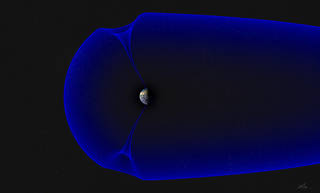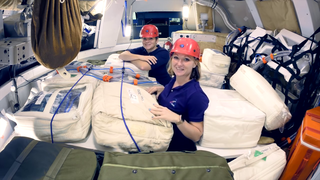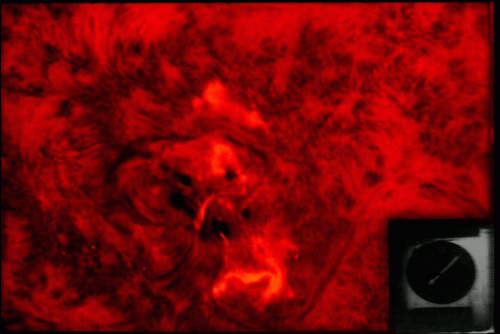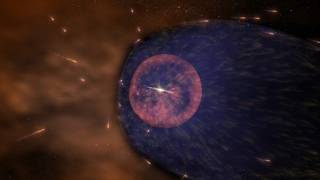How NASA Will Protect Astronauts From Space Radiation at the Moon
August 1972, as NASA scientist Ian Richardson remembers it, was hot. In Surrey, England, where he grew up, the fields were brown and dry, and people tried to stay indoors — out of the Sun, televisions on. But for several days that month, his TV picture kept breaking up. “Do not adjust your set,” he recalls the BBC announcing. “Heat isn’t causing the interference. It’s sunspots.”

Earth’s magnetic bubble, called the magnetosphere, is illustrated in blue. The magnetosphere provides natural protection against space radiation, deflecting most charged solar particles from Earth.
The same sunspots that disrupted the television signals led to enormous solar flares — powerful bursts of energy from the Sun — Aug. 4-7 that year. Between the Apollo 16 and 17 missions, the solar eruptions were a near miss for lunar explorers. Had they been in orbit or on the Moon’s surface, they could have experienced high levels of radiation sparked by the eruptions. Today, the Apollo-era flares serve as a reminder of the threat of radiation exposure to technology and astronauts in space. Understanding and predicting solar eruptions is crucial for safe space exploration.

Jessica Vos (foreground), deputy health and medical technical authority for Orion, and astronaut Anne McClain (background) demonstrate the radiation protection plan in a representative Orion spacecraft. During an SEP event, the crew will use stowage bags on board Orion to create a dense shelter from radiation.
Almost 50 years since those 1972 storms, the data, technology and resources available to NASA have improved, enabling advancements towards space weather forecasts and astronaut protection — key to NASA’s Artemis program to return astronauts to the Moon.
Space isn’t empty
Today, Richardson is a scientist at NASA’s Goddard Space Flight Center in Greenbelt, Maryland. He studies high-energy particles that burst from the Sun in the wake of giant solar eruptions.

The Aug. 7, 1972, solar flare was captured by the Big Bear Solar Observatory in California. This particular flare — known as the seahorse flare for the shape of the bright regions — sparked a strong SEP event that could have been harmful to astronauts if an Apollo mission had been in progress at the time.
In addition to flares, huge clouds — called coronal mass ejections — containing a billion tons of solar material occasionally blast from the solar surface. Increasingly, scientists think coronal mass ejections play a dominant role in driving the Sun’s most powerful radiation: solar energetic particles, or SEPs.

This animated image shows the solar system and the Sun’s magnetic bubble, called the heliosphere, that extends far beyond it. Bright streaks represent cosmic rays. During solar maximum, as the heliosphere strengthens, it blocks more cosmic rays.
SEPs are almost all protons, flung at such high speeds that some reach Earth, 93 million miles away, in less than an hour. “When a high-speed boat goes through water, you can see the wave ahead of it,” Richardson said. “The shock waves ahead of fast coronal mass ejections accelerate particles before them.”
Radiation is energy packaged in electromagnetic waves or carried by particles. The energy is handed off when the wave or particle runs into something else, like an astronaut or spacecraft component. SEPs are dangerous because they pass right through skin, shedding energy and fragmenting cells or DNA on their way. This damage can increase risk for cancer later in life, or in extreme cases, cause acute radiation sickness in the short-term.
On Earth, humans are safe from this harm. Earth’s protective magnetic bubble, called the magnetosphere, deflects most solar particles. The atmosphere also quells any particles that do make it through. The International Space Station cruises through low-Earth orbit, within Earth’s protection, and the station’s hull helps shield crew members from radiation too.
But beyond Earth’s magnetic reach, human explorers can face the harsh radiation of space.
“The danger of radiation is always present, whether you’re in orbit, in transit, or on a planetary surface,” said Ruthan Lewis, a Goddard architect and engineer for NASA’s human spaceflight program. “From mitigation techniques to protection and enclosures, we’re considering this in every environment astronauts will be in.”
Space lifeguards
In a room filled with expansive computer screens and blinking lights at NASA’s Johnson Space Center in Houston, scientists work daily shifts to monitor space weather conditions for astronauts on the space station. Known as space environment officers, they’re the lifeguards of space: Instead of tidal waves and rip currents, they keep watch for the ebb and flow of space radiation.
Each day, the scientists — who are part of Johnson’s Space Radiation Analysis Group — check the space weather forecast from the National Oceanic and Atmospheric Administration’s Space Weather Prediction Center. They alert mission control of potential solar activity. If solar energetic particles are ramping up and the space station happens to be passing outside Earth’s magnetic protection, they might recommend postponing activities that require leaving the safety of the station. Anywhere astronauts go, the group will keep watch over their space environment.
During a future Artemis mission, if a solar radiation squall were to occur while astronauts are beyond Earth’s magnetic bubble, they might tell the crew to build a temporary shelter. “Our strategy in space is to make use of whatever mass is available,” Johnson scientist Kerry Lee said. “We’re redistributing mass to fill in areas that are thinly shielded and getting crew members closer to the heavily shielded areas.”
The more mass between the crew and radiation, the more likely that dangerous particles will deposit their energy before reaching the crew. On the Moon, astronauts could pile lunar soil, or regolith, over their shelters, taking advantage of their environment’s natural shielding materials. But where spacecraft design is concerned, relying on sheer bulk for protection soon grows expensive, since more mass requires more fuel to launch.
The Johnson team works on developing shielding methods without adding more material. “It’s unlikely that we’re going to be able to fly dedicated radiation-shielding mass,” Lee said. “Every item you fly will have to be multi-purpose.”
For the Orion spacecraft, they’ve designed a plan for astronauts to build a temporary shelter with existing materials on hand, including storage units already on board or food and water supplies. If the Sun erupted with another storm as strong as the Apollo era’s, the Orion crew would be safe and sound.
Other teams across NASA are meeting the radiation challenge with creative solutions, developing technology such as wearable vests and devices that add mass, and electrically charged surfaces that deflect radiation.
Here come the Sun’s energetic particles
Protecting astronauts from solar energetic particle storms requires knowing when such a storm will occur. But the particle flurries are fickle and difficult to predict. The nature of the Sun’s turbulent eruptions is not yet perfectly understood.
“Ideally, you could look at an active region on the Sun, see how it’s evolving, and try to predict when it’s going to erupt,” Richardson said. “The problem is, even if you could forecast flares and coronal mass ejections, only a small fraction actually spawn the particles that are hazardous to astronauts.”
And, if SEPs do come, it’s hard to predict where they will go. Magnetic field lines are a highway for the charged particles, but as the Sun rotates, the roadways spiral. Some particles are knocked off-road by kinks in the field lines. As a result, they may spread far and wide through the solar system, in a vast, nebulous cloud.
“We still have a long way to go to get to the same position as weather forecasting on Earth,” said Yari Collado-Vega, a scientist at the Community Coordinated Modeling Center, or CCMC, which is housed at Goddard. The CCMC is a multi-partnership agency dedicated to space weather modeling and research. “This has to do with the fact that we just don’t have as many data sets on the Sun.”
Models to predict when SEPs will arrive are in the early stages of development. One uses the arrival of lighter and faster electrons to forecast the torrent of heavier protons that follow, which are more dangerous.
Scientists depend on NASA’s heliophysics missions to advance their space weather forecasting models. It helps to have spacecraft at different vantage points between the Sun and Earth. Launched in 2018, NASA’s Parker Solar Probe is flying closer to the Sun than any spacecraft before it. The spacecraft will track SEPs near their origins — key to solving how solar eruptions accelerate particles.
Timing is a factor too. The Sun swings through 11-year cycles of high and low activity. During solar maximum, the Sun is freckled with sunspots, regions of high magnetic tension that are ripe for eruption. During solar minimum, when there are little to no sunspots, eruptions are rare.
While scientists continue to improve their models, NASA’s heliophysics spacecraft do currently provide the observations that NASA needs to give astronauts an “all-clear” — the okay to conduct mission activity. If there are no active sunspots on the Sun, they can reliably say there won’t be a solar squall.
Radiation from next-door galaxies
A second kind of space radiation travels even farther than solar energetic particles. Galactic cosmic rays — particles from long-gone, exploded stars elsewhere in the Milky Way — constantly bombard the solar system at near-light speeds. If solar energetic particles are a sudden downpour, galactic cosmic rays are more like a steady drizzle. But a drizzle can be a nuisance too.
Cosmic rays tend to be more powerful than even the most energetic solar particles. The same spacecraft that would shield a crew from solar energetic particles would not be able to keep cosmic rays at bay, so cosmic rays are a serious concern, especially for long-duration missions like the journey to Mars, which will take six to 10 months each way.
While SEPs are tricky to predict, galactic cosmic rays come at a steady rate. In one second, some 90 cosmic rays strike a pocket of space the size of a golf ball. (Meanwhile, during an SEP shower, there could be 1,000 more particles ripping through that golf-ball-sized space.) This rate helps determine radiation limits and mission durations — NASA’s leading strategy to limiting cosmic ray exposure. NASA tracks astronauts’ individual doses to ensure they don’t breach lifetime limits.
Cosmic rays are comprised of heavy elements like helium, oxygen or iron. The hefty particles knock apart atoms when they collide with something, whether an astronaut or the thick metal walls of a spacecraft. The impact sets off a shower of more particles called secondary radiation — adding to the health concern of cosmic rays.
Cosmic ray exposure is also related to the solar cycle. In the relative calm of solar minimum, cosmic rays easily infiltrate the Sun’s magnetic field. But during solar maximum, the Sun’s magnetic bubble strengthens with increased solar activity, turning away some of the galactic visitors who come knocking.
Destination: Moon, then Mars
Going to the Moon will help NASA collect crucial data and develop the necessary tools and strategies to one day safely send human explorers to Mars. The journey to Mars will take much longer than a trip to the Moon, and crew members will face much more radiation exposure. And, unlike Earth, Mars has no magnetic field to divert radiation.
“One of the reasons we’re going to the Moon is in preparation for Mars,” Lewis said. Sustained lunar exploration will help determine whether we have the technology needed to protect astronauts on longer-term space travel. “We’ve done a lot of simulations. Now we’re going to start cutting metal.”
Source: U.S. National Aeronautics and Space Administration
- 244 reads
Human Rights
Ringing FOWPAL’s Peace Bell for the World:Nobel Peace Prize Laureates’ Visions and Actions

Protecting the World’s Cultural Diversity for a Sustainable Future

The Peace Bell Resonates at the 27th Eurasian Economic Summit

Declaration of World Day of the Power of Hope Endorsed by People in 158 Nations

Puppet Show I International Friendship Day 2020

